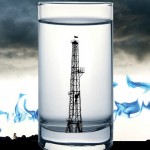 Kids learn in a basic science experiment that when you try to mix oil and water, oil will float to the top, because the two substances don’t mix. I had to think back to such experiments when reading a report on Water Innovation in Oil and Gas 2014, published by the London Environmental Investment Forum and sponsored by Veolia.
Kids learn in a basic science experiment that when you try to mix oil and water, oil will float to the top, because the two substances don’t mix. I had to think back to such experiments when reading a report on Water Innovation in Oil and Gas 2014, published by the London Environmental Investment Forum and sponsored by Veolia.
The water sector sees a major new growth opportunity in the development of unconventional fossil fuels, such as shale gas, tight gas and coal-bed methane. These oil and gas resources can only be extracted by the use of fracking, which involves injecting millions of litres of water at high pressure underground, mixed with sand and (at times toxic) chemicals.
Supplying the water to an oil and gas industry which is thirstier than ever is a major opportunity. However, the real jackpot seems to be in the massive amounts of highly contaminated wastewater that the fossil fuel industry will generate in the years ahead. After shale oil or gas wells have been fracked, a variable amount of contaminated water (industry calls it “produced water”) tends to come to the surface and requires treatment.
The water industry is already looking forward to the 500 million barrels of “produced water” per day by 2020. To put this in perspective, 500 million barrels of wastewater is the equivalent of the water consumed by the city of London every year, times 40!
For some of us who consider water a scarce and precious resource, such volumes of wastewater sound horrific. But the water industry sees a major “growth market.” The more wastewater, the better, in their view! Of course, this report is supposed to attract investors to the sector. So, the authors have an interest in exaggerating the “potential.” But even if the volumes were only one half or one third of what’s projected, we’re still talking massive amounts of waste(d) water.
But can nothing be done about the growing thirst of the oil and gas industry? Sure, lots of things … but not without some negative side-effects:
“New chemicals can eliminate or reduce water use in oil and gas extraction. But this can lead to new water treatment challenges when these chemicals reappear in the flow-back water.”
The authors seem to admit that eliminating one challenge seems to be creating a host of new problems. So much for greener, more environmentally benign forms of fracking. It’s good to get this message straight from the horse’s mouth.
The so-called produced water is not just your household wastewater, says one of the experts quoted in the report:
“Produced water is as varied as the geology of our planet. It is drawn from far, far greater depths than potable groundwater for public supply […] It is contaminated in elaborate and unexpected ways. No two samples are the same, and even the same sample can exhibit different characteristics between the time it is taken from the oil field, and the time it is subjected to analysis in the laboratory”.
It sure sounds complicated to find the right treatment for the wastewater coming from hundreds of different wells in, for example, a shale play!
We know that Big Oil & Gas is planning to (continue to) ruin the climate. What we are learning from this report is that this industry also seems intent on destroying lots of fresh water in the process. The major “growth markets” for polluted water are situated in the Middle East, United States (tight oil), Canada (tar sands) and coal seam gas (Australia).
However, the authors have the highest hopes for the amount of polluted water that will need to be treated in China. Given China’s air pollution problems due to its reliance on coal-fired power generation, the Chinese government is trying to move away from coal by using more renewable energy, becoming more energy efficient, using more natural gas, etc. This leaves potentially a lot of cheap Chinese coal unused, which can be diverted to making other fossil fuels such as “coal to liquids, coal to chemicals and coal to gas — known collectively as CTX”.
This is great news for investors in the water and water treatment sector for two reasons, according to the report. First of all, such CTX technologies are “heavy water users”: It takes 10 litres of fresh water to produce one litre of crude oil. Secondly, CTX generate “a difficult to treat wastewater complete with toxins such as mercury […]”.
The authors ask the rhetorical question:
“What could possibly go wrong? This sounds like the perfect storm of need, innovation and capital”.
We can think of a couple of things that could go wrong! Poor monitoring by public authorities, companies cutting corners, water shortages, more climate pollution, etc. The report offers an insight in Veolia’s corporate wish list of creating new, profitable waste streams, shifting fossil fuel pollution from one area to another. In other words, not actually cleaning up our energy system, but just making some money from creating new problems.
I’m not sure about you, but investing in renewables and energy efficiency has never sounded better!


